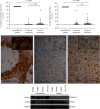Testis-Specific Thioredoxins TXNDC2, TXNDC3, and TXNDC6 Are Expressed in Both Testicular and Systemic DLBCL and Correlate with Clinical Disease Presentation
- PMID: 33603952
- PMCID: PMC7870302
- DOI: 10.1155/2021/8026941
Testis-Specific Thioredoxins TXNDC2, TXNDC3, and TXNDC6 Are Expressed in Both Testicular and Systemic DLBCL and Correlate with Clinical Disease Presentation
Abstract
DLBCL is the most common type of non-Hodgkin lymphoma with a substantial group of patients suffering a poor prognosis. Therefore more specific markers are required for better understanding of disease biology and treatment. This study demonstrates that testis-specific antioxidant enzymes TXNDC2, TXNDC3, and TXNDC6 alongside oxidative stress marker 8-OHdG are expressed in both testicular and systemic DLBCL, and their presence or absence has correlations with clinical risk factors such as the number of extranodal effusion, the appearance of B-symptoms, and treatment response. Biopsy samples were collected from 28 systemic and 21 testicular male DLBCL patients. The samples were histostained with TXNDC2, TXNDC3, TXNDC6, and 8-OHdG, then graded by a hematopathologist blinded to clinical data. Immunoelectron microscopy was used as a second method to confirm the reliability of the acquired immunohistochemistry data. The absence of nuclear TXNDC2 expression in testicular DLBCL cells correlated with worse primary treatment response, cytoplasmic TXNDC3 expression in testicular and systemic DLBCL associated with lower frequency of B-symptoms, and TXNDC6 expression in cytoplasm in systemic DLBCL had a clinical significance with higher LD levels suggesting a role in the biological nature of these lymphomas. Overall, TXNDC3 cytoplasmic expression is correlated with a more positive outcome in both testicular and systemic DLBCL, while TXNDC6 cytoplasmic expression is associated with a negative outcome in systemic DLBCL.
Copyright © 2021 Mikko C. Chan et al.
Conflict of interest statement
No potential conflict of interest was reported by the authors.
Figures





References
MeSH terms
Substances
LinkOut - more resources
Full Text Sources
Other Literature Sources
Medical
Molecular Biology Databases
Research Materials

